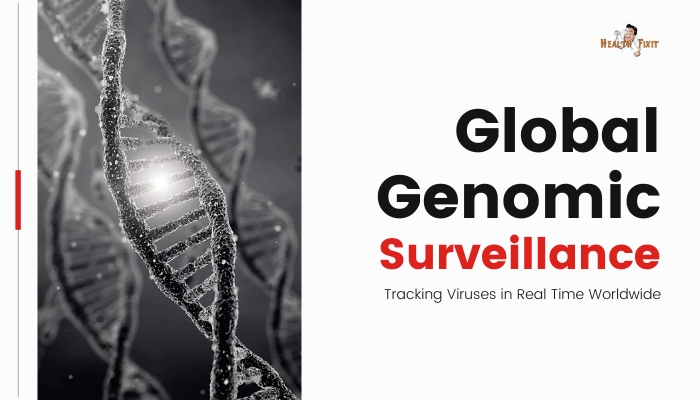Introduction
From HIV to COVID-19, new viral threats continually challenge global health. An essential tool in modern public health is genomic surveillance—tracking viruses by regularly sequencing their genomes in real time
. These efforts help detect new variants, monitor transmission pathways, and guide strategies like vaccine updates or travel advisories.
By uniting laboratories, data-sharing platforms, and cutting-edge analytics, genomic surveillance supports a proactive approach to pandemic prevention.
This article explores how global genomic surveillance works, the innovations driving it, and the impact on our readiness for future infectious disease outbreaks.
What Is Genomic Surveillance?
Beyond Traditional Diagnostics
Classic diagnostics confirm a pathogen’s presence but rarely reveal genetic details. Genomic surveillance goes deeper by sequencing the pathogen’s entire genome or critical segments, uncovering mutations that may affect transmissibility, virulence,
or drug susceptibility. As viruses evolve rapidly, these insights often come faster than clinical signs, allowing public health authorities to anticipate trouble and intervene.
Global Networks and Data Sharing
International consortia (e.g., GISAID, Nextstrain) enable labs worldwide to upload viral sequences
. Researchers track variants in real time and visualize their spread on dynamic maps. Such open collaboration proved pivotal during COVID-19, guiding vaccine updates and public health measures.
Key Components of a Global System
Sequencing Technologies
Next-generation sequencing (NGS) platforms—like Illumina or Oxford Nanopore—process virus samples quickly, often delivering near-complete genomes within hours. As costs drop, more labs can adopt these technologies, expanding surveillance footprints.
Bioinformatics and Analytics
Huge volumes of viral sequence data demand robust computational pipelines. Tools like Nextstrain or Phylogenetic algorithms reconstruct viral family trees, highlighting how a variant’s subtle mutations cluster in certain regions or subpopulations.
Real-Time Data Visualization
Web-based dashboards or specialized platforms let health officials see variant prevalence and mutation hotspots globally. This helps them respond with localized lockdowns, targeted testing, or resource reallocation.
Applications and Benefits
Early Variant Detection
A hallmark success was the rapid identification of SARS-CoV-2 variants (e.g., Delta, Omicron). By analyzing sequences from multiple countries
, scientists flagged changes in the virus’s spike protein that correlated with increased transmissibility, prompting timely changes to public guidance.
Vaccine and Therapeutic Updates
Knowing which viral mutations might evade immunity or reduce drug effectiveness spurs updates to vaccines (like mRNA boosters) and monoclonal antibodies. Ongoing surveillance ensures these countermeasures remain potent against new variants.
Stopping Future Pandemics
Beyond SARS-CoV-2, genomic surveillance systems now watch for influenza drift, Ebola reemergence, and potential zoonotic viruses in wildlife. If a dangerous novel pathogen arises, global networks can swiftly ring alarms, directing containment and R&D.
Challenges and Limitations
Sequencing Gaps
Despite expansions, many low-income regions lack consistent sequencing infrastructure. Viruses can spread or mutate undetected in these blind spots, undercutting global efforts.
Data Sharing Barriers
Some nations hesitate to share genomic data promptly, citing concerns over intellectual property or security. Encouraging open, transparent collaboration is crucial to truly global surveillance.
Technical Complexity
Sequencing errors, incomplete coverage, or misinterpretation of phylogenetic data can lead to confusion—like false variant announcements. Ensuring strong quality controls and robust analytics training is paramount.
Ethical and Legal Issues
Balance must be struck between public health benefits of transparent data and privacy or sovereignty concerns. Genetic information about viruses from a region might link to local patient data or exploitation of intellectual property if not carefully managed.
Future Outlook: Improved Preparedness
Affordable, Rapid Sequencing
Miniaturized, portable devices promise near-real-time onsite sequencing at outbreak zones. This democratizes access, so field labs can decode a novel virus quickly, even in remote areas.
Integrative One Health Surveillance
Merging wildlife, livestock, and human genomic data fosters an integrated approach. By scanning for pathogens crossing from animals to people, officials can preempt the next epidemic. AI-based modeling can combine these multi-sector datasets, refining early warning systems.
Ongoing Partnerships
Global institutions—like WHO’s Pandemic Influenza Preparedness framework—could replicate that success for other pathogens.
Partnerships between countries, philanthropic foundations, and private organizations help standardize protocols and build trust in shared results.
Practical Guidance for Health Professionals
- Stay Updated on Tools: Familiarize yourself with public platforms (GISAID, Nextstrain) for real-time variant tracking.
- Advocate for Local Sequencing: Encourage investment in local labs’ ability to rapidly sequence pathogens, bridging data gaps.
- Integrate Clinical and Genomic Data: Combine patient outcome info with virus variants to identify potential shifts in transmissibility or severity.
- Communication: Share findings with policymakers early, so they can adopt timely, evidence-based measures.
Conclusion
Global genomic surveillance stands at the frontier of modern epidemiology, enabling scientists and public health authorities to spot and respond to viral threats almost as they emerge. By harnessing next-generation sequencing, advanced bioinformatics
, and an ethos of open data sharing, we inch closer to proactive disease prevention. While logistical, ethical, and funding challenges persist,
the rapid identification of new variants—and near-instant collaboration around the world—demonstrate genomic surveillance’s transformative potential.
As new pathogens inevitably surface, these real-time global efforts may well determine whether tomorrow’s outbreak remains a local curiosity or escalates into a worldwide crisis.
References
- Hadfield J, Megill C, Bell SM, et al. Nextstrain: real-time tracking of pathogen evolution. Bioinformatics. 2018;34(23):4121–4123.
- Andersen KG, Rambaut A, Lipkin WI, et al. The proximal origin of SARS-CoV-2. Nat Med. 2020;26(4):450–452.
- Shu Y, McCauley J. GISAID: Global initiative on sharing all influenza data – from vision to reality. Eurosurveillance. 2017;22(13):30494.
- Holmes EC, Dudas G, Rambaut A, Andersen KG. The evolution of Ebola virus: Insights from the 2013–2016 epidemic. Nature. 2016;538(7624):193–200.
- van Dorp L, Richard D, Tan CCS, et al. No evidence for increased transmissibility from recurrent mutations in SARS-CoV-2. Nat Commun. 2020;11(1):5986.
- Chiara M, et al. Next-generation sequencing in pathogen genomics to track outbreak evolution and transmission. Brief Funct Genomics. 2021;20(3):151–162.
- WHO. Pandemic Influenza Risk Management Guidance. 2017.
- Bull RA, et al. Analytical validity of targeted next-generation sequencing for virus detection. PLoS ONE. 2016;11(8):e0161695.
- Morens DM, Daszak P, Markel H, Taubenberger JK. Pandemic COVID-19 joins history’s pandemic legion. mBio. 2020;11(3):e00812-20.
- Faria NR, Quick J, Theze J, et al. Establishment and cryptic transmission of Zika virus in Brazil and the Americas. Nature. 2017;546(7659):406–410.



